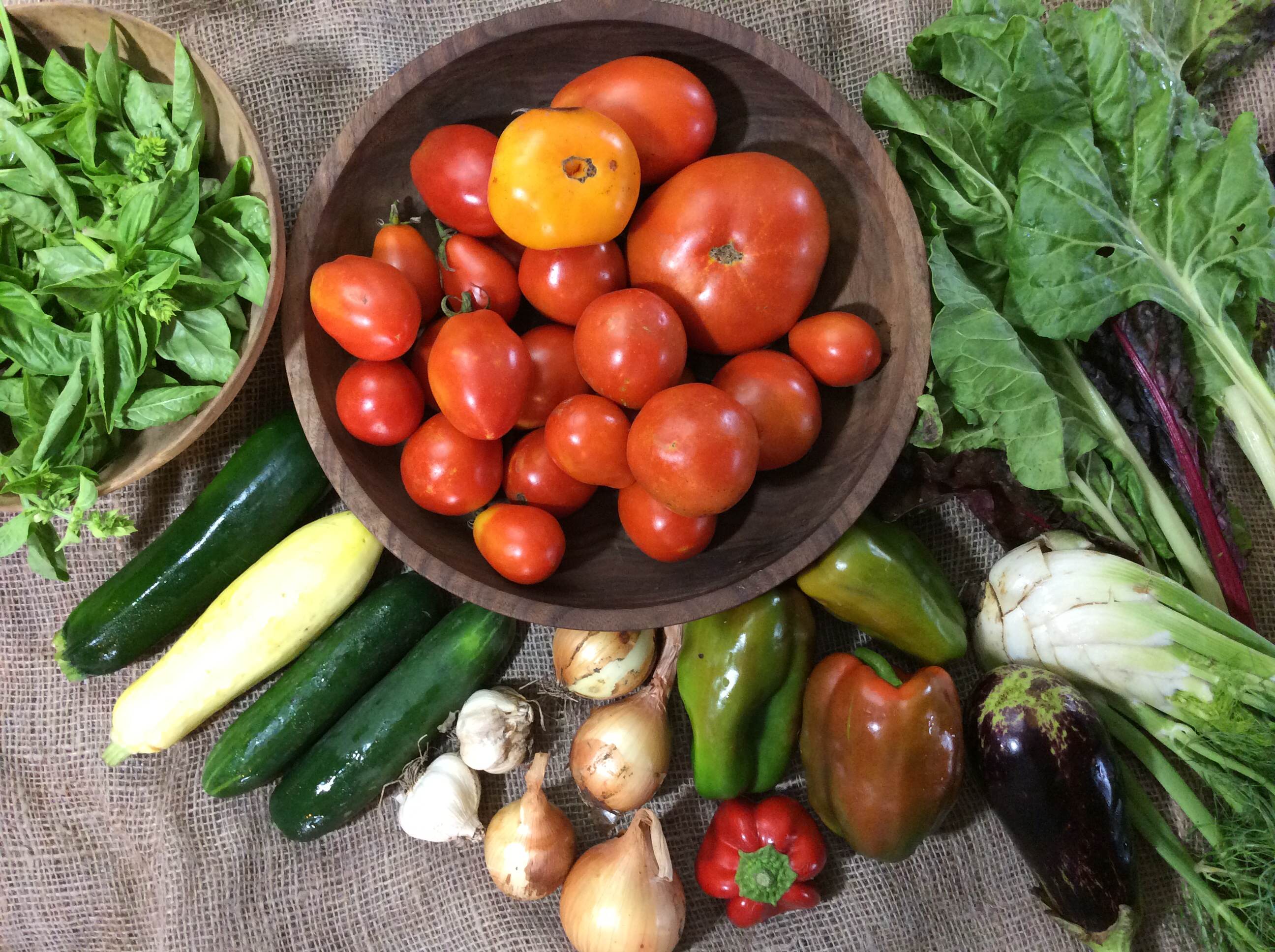Week 9 of the Redfearn CSA includes (beginning in the top left of the pictured large share):Basil, Tomatoes, CHOICE of Swiss Chard (pictured) OR Kale, CHOICE of Fennel Bulb (pictured) OR Eggplant OR bag of peppers (jalapeños, anaheim and sweet banana peppers will be available), Sweet Bell Peppers, Candy Onions, Garlic bulbs, Cucumbers and Zucchini/ summer squash. On the choices: Small shares choose 1, Large shares choose 2 (mix or match) for EACH of the choices.
Basil: To keep basil fresh, trim the stems and place them in a glass or jar of water, just like cut flowers. Loosely cover it with a plastic bag and leave it on the counter. Although certain herbs, such as parsley and cilantro, can be stored this way in the fridge, basil does better at room temperature. Here are some ways to use basil: top sliced tomatoes with chopped basil and olive oil, make Pesto, or use to season italian dishes. If you need to preserve basil leaves; it can be pureed with olive oil and frozen (in ice cube trays or small plastic bags. For more detailed instructions for preserving basil, click here.
Tomatoes: Store at cool room temperature, in a single layer if possible, NOT in a plastic bag. Let tomatoes ripen at room temperature. Here is a website that gives many different Tomato Salad Ideas. This Roasted Tomato Tart recipe is a favorite of mine. Another favorite is Ricotta- Stuffed Tomatoes or these Parmesan Tomatoes. Here are additional tomato recipes: Rice- stuffed tomatoes, Fresh Tomato Pie, Caprese salad, Tomato Basil Chicken , Panzanella Salad, orIsraeli Salad (and a more complicated/ authentic Israeli Salad).
Sweet peppers: Store in plastic bag, in refrigerator. Meal idea: sauté sliced candy onions and sweet pepper for a tasty Philly Cheese Sandwich or Fajitas. Stuffed peppers are also a favorite main dish at our house; zucchini/ yellow squash can also be stuffed using the same recipe.
CHOICE of Swiss Chard (pictured) or Kale:
Swiss Chard: Store in plastic bag in the refrigerator. The swiss chard leaves have a very mild flavor similar to spinach. Both the stem and the leaves can be eaten and I usually use both together; chop the stems like you would celery and begin cooking the stems before adding the greens. This is a basic swiss chard recipe: Swiss Chard with Balsamic Vinegar. Our family really likes this Swiss Chard, Sausage, White bean casserole ( I use the stems and leaves of the chard). This Swiss Chard and Ricotta Crostata is a wonderful recipe, and one of my all-time favorites. Swiss chard leaves can be used just like spinach in my Crustless Spinach Quiche recipe. Swiss chard can also be used in curry, as in these: Saag Paneer (I have used a bunch of swiss chard in place of spinach in this recipe; I washed, then coarsely chopped the chard stems and leaves, and then processed the swiss chard while raw in a food processor) and Curried Lentils and Sweet Potatoes.
Kale: store in plastic bag in refrigerator. Baby Kale is great in Kale salad or in any kale dish, but it doesn’t need as much time to cook. Try this Zuppa Tuscana soup (I usually add a can of tomatoes to this soup and sometimes kidney beans). Or, try this method of fixing kale:
Kale, Sausage and Beans
8 to 16 oz. smoked sausage (or omit and increase beans, for a vegetarian version), sliced
1 Onion, chopped
3 (or more) cloves garlic, finally chopped
1 can (or about 2 cups, peeled) tomatoes, with liquid
Kale, 7- 10 leaves, removed from stem and chopped (with Baby kale, add a couple handfuls of kale leaves, chopped)
1 can drained (or about 2 Cups, cooked) white beans, like great northern or cannellini beans
Brown the sausage in a skillet and then remove sausage to a paper towel lined plate and drain off excess oil. Saute the onions in olive oil over medium heat, till soft and golden, 5- 10 minutes. Add chopped garlic and kale, stir to begin to wilt. Then add tomatoes and cover: lower heat and cook until kale is tender, about 5 to 7 minutes, stirring occasionally. Stir in beans and sausage and season to taste (red pepper flakes are a good addition). Can be topped with shredded parmesan cheese.
Onions: store at cool room temperature.
Garlic: store at cool room temperature.
Zucchini/ summer squash: store in plastic bag in refrigerator. Zucchini is great raw or sautéed, grilled, or baked into zucchini bread (my kids favorite way to eat zucchini!). Raw zucchini/ squash makes a fresh, flavorful salad as in this: Summer Squash Salad with Lemon Citronette. Zucchini (sliced and broiled or pan fried) can take the place of pasta in lasagna. If you want more ideas, you can try Baked Zucchini Fries, Squash baked eggs or Zucchini Fritters (these were very good) or Chocolate Zucchini Bread or this main dish Cheesy Zucchini Casserole (which we make with shredded sharp cheddar, instead of Velvetta). Here’s a couple other zucchini recipes, recommended by CSA members: Curried Zucchini Soup, Sauteed Zucchini with Cherry Tomatoes (don’t overcook the zucchini!), and Zucchini Chocolate Rum Cake.
Cucumbers: Store in plastic bag in refrigerator. Pair with tomatoes in an Israeli Salad, Cucumber, Tomato, and Avocado Salad, Panzanella Salad. Cucumbers are the base for the Mediterranean sauce, Tzatziki.
CHOICE of Fennel Bulb (pictured) OR Eggplant OR bag of peppers (jalapeños, anaheim and sweet banana peppers will be available).
Eggplant: Store in plastic bag in the refrigerator, but use quickly, because eggplant doesn’t store well. The best tip I have for tasty eggplant is to salt and drain the prepared (sliced, cubed, etc) eggplant for at least 20-30 minutes before cooking (this takes away any bitterness and also, helps the eggplant to absorb less oil during cooking). Here’s a page with detailed instructions about eggplant preparation and recipes: Fine Cooking: How to cook Eggplant. Eggplant can be sauteed, grilled or roasted. It is great combined with zucchini and other vegetables and grilled for a summer side dish. For eggplant recipes from Italy to China, check out these: Global Eggplant Recipes. A wonderful eggplant recipe (and one that doesn’t require salting and draining the eggplant) is Smitten Kitchen’s Eggplant Bruschetta (which has a Mediterranean style topping).
Fennel: Store in a plastic bag in the refrigerator. There are three parts to fennel: the bulb, the stalks and the fronds (the dill-like frilly top). The bulb is the most commonly used part of the vegetable in recipes; such as Caramelized Fennel or a Fennel Salad (this one is paired with blood oranges). The fennel stalks can be used when making vegetable/ chicken stock to add a subtle fennel flavor (the fennel stalks can be frozen to store). The fennel stalks are a bit tougher than the bulb, but can also be very thinly sliced and added to the fennel bulb slices. This leek and fennel soup uses all the parts of the fennel (and is a vegan recipe) and Tomato-Fennel Soup is also popular. And this Crispy Cream-braised Potatoes and Fennel is very tasty. This page lists a variety of fennel recipes: Fennel recipes you will make over and over. One fennel bulb is also used in this Swiss Chard, Sausage, White bean casserole .
Spicy peppers: Store in plastic bag, in refrigerator. Jalapeños or Anaheim peppers can be chopped and add to salsa, or use in this Jalapeno Popper Chicken. If you want to try water-bath canning, try this Jalapeno Jelly (I’ve used a combination of peppers). Anaheim and poblano peppers can be stuffed, as in these Chicken and Cheese Stuffed Anaheim Peppers, or Black beans and Cheese stuffed Poblano Peppers, or Rice and Beef stuffed Peppers. Peppers can be frozen; slice or dice and then place in freezer bags, can be used in fajitas, or anywhere you would use cooked peppers (after thawing the peppers are soft). Banana peppers can also be stuffed as in this Stuffed Banana Peppers with Bacon recipe.

